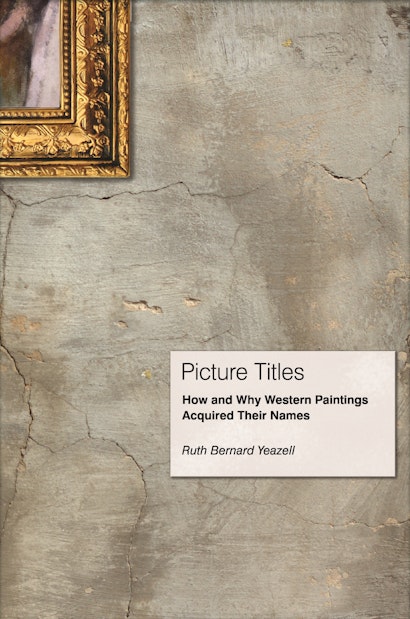A picture’s title is often our first guide to understanding the image. Yet paintings didn’t always have titles, and many canvases acquired their names from curators, dealers, and printmakers—not the artists. Taking an original, historical look at how Western paintings were named, Picture Titles shows how the practice developed in response to the conditions of the modern art world and how titles have shaped the reception of artwork from the time of Bruegel and Rembrandt to the present.
Ruth Bernard Yeazell begins the story with the decline of patronage and the rise of the art market in the seventeenth and eighteenth centuries, as the increasing circulation of pictures and the democratization of the viewing public generated the need for a shorthand by which to identify works at a far remove from their creation. The spread of literacy both encouraged the practice of titling pictures and aroused new anxieties about relations between word and image, including fears that reading was taking the place of looking. Yeazell demonstrates that most titles composed before the nineteenth century were the work of middlemen, and even today many artists rely on others to name their pictures. A painter who wants a title to stick, Yeazell argues, must engage in an act of aggressive authorship. She investigates prominent cases, such as David’s Oath of the Horatii and works by Turner, Courbet, Whistler, Magritte, and Jasper Johns.
Examining Western painting from the Renaissance to the present day, Picture Titles sheds new light on the ways that we interpret and appreciate visual art.
Awards and Recognition
- One of The New Yorker’s “The Books We Loved in 2015” (selected by Ben Lerner)
"I was fascinated by Ruth Bernard Yeazell's book Picture Titles: How and Why Western Paintings Acquired Their Names. As a writer who is often jealous of visual artists, I found her exploration of how titles inflect our experiences of viewing perversely reassuring—I mean as evidence of the power a text can hold over an image."—Ben Lerner, New Yorker
"A fascinating account of how paintings get their titles."—Peter De Bolla, Times Literary Supplement
"This fascinating study shows how the naming of paintings was inextricably tied to the rise of the art market in the 17th and 18th centuries."—Apollo Magazine
"Yeazell's work is undoubtedly one of serious scholarship, stuffed to the margins with historical and critical analysis. . . . Where Yeazell's analysis succeeds most is in its insistence that we consider something that seems so ordinary—a wall label, photo caption, or Google Images description—with consideration of those words' creator and with an awareness of how those words profoundly affect our perception."—Grace Labatt, Santa Fe New Mexican
"That titles are somehow intrinsic to all artworks is an idea that is mistaken but frequently espoused. Welcome clarification of this fact comes with Ruth Bernard Yeazell's new book, Picture Titles: How and Why Western Paintings Acquired Their Names. This is an important study."—Thomas Marks, Apollo Magazine
"The advent of titles in Western art is the subject of this engaging book. Yeazell explores the economic and cultural changes that prompted the practice, blending historical perspective with more modern case studies. . . . Well organized and including detailed references and a thorough index, this is a valuable resource for those interested in art history, library and museum studies, and fine arts."—Choice
"'In the past few years, there has been a vogue in art history for projects, conference sessions, and publications that deal with connections between art and text. For anyone intending to enter this arena, Ruth Bernard Yeazell's Picture Titles has positioned itself as a must read. . . . The author has made excellent use of primary and interdisciplinary historical resources from around the globe. . . . All of this meticulous research has been delivered with a large dosage of common sense, which is very refreshing.""—Colleen Truax Yarger, Art Inquiries
"Reading her text is to take a graduate level course in art history. It is truly education at the highest level. . . . Yeazell’s book is a pleasure to read on so many levels."—George Matejka, Names
"Picture Titles is more than just a historical account of how and why pictures came to be named, and of how and why these names sometimes changed over time—it also explores how the act of bestowing a title on a picture influences the ways we approach and apprehend it. After reading this highly original and beautifully written book, you will never look at another picture in quite the same way again."—David Cannadine, author of The Undivided Past: Humanity beyond Our Differences
"Between emblematic text banners in medieval painting and conceptualist works that are all caption, Picture Titles tracks the emergence and rapid evolution of named pictures and inquires into the mutating claims of ‘painter as author.' Invitingly erudite and anecdotal at once, this short history is long on explanatory grip. Works by artists as different as David and Courbet, Magritte and Johns, get read anew through the logic of appellation itself."—Garrett Stewart, University of Iowa
"This is a terrific book. It's very well argued, intellectually provocative, and immensely enjoyable. No one who reads it will ever again consider a painting's title as something incidental and to be taken for granted. In many ways, Yeazell tells the history of Western art consumption through this hugely important topic."—Kate Flint, University of Southern California
"Picture Titles is an eloquent and deeply researched book on a subject that is deserving of a more focused attention than it has received in the past. Raising interesting questions about the relation between verbal and pictorial literacy, this book will have many appreciative readers in a range of different disciplines."—Leonard Barkan, Princeton University


